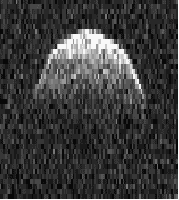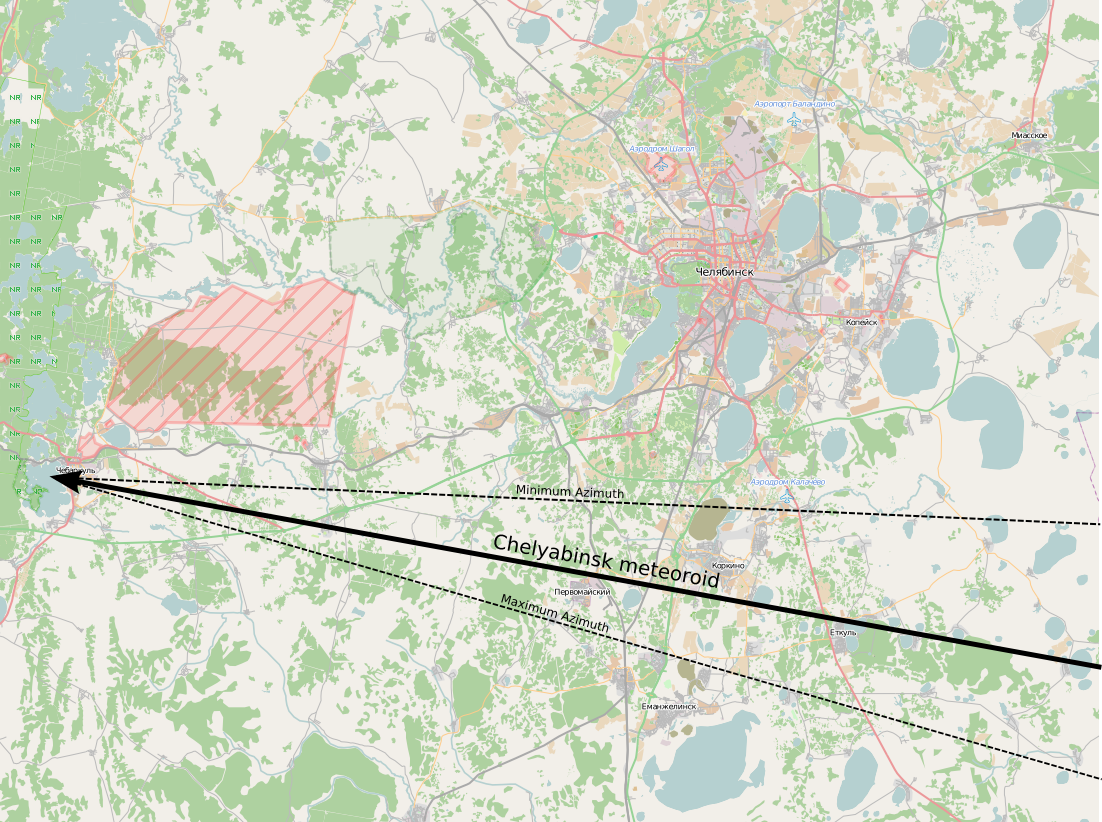|
2013 XY8
is a near-Earth Apollo asteroid that passed from Earth on 11 December 2013. It passed by Earth at about 2 lunar distances, and was discovered 5 days previously, on 7 December 2013. At across it is bigger than the estimated size of the Chelyabinsk meteor impact of 2013. has been observed by radar and has a well determined orbit. It will pass about from the Moon on 11 December 2095. 2013 XY8 was detected by the Catalina Sky Survey and follow up observations were conducted with the Faulkes Telescope South . It was described as being about the size of the Space Shuttle and was reported to be traveling at 14 kilometers per second (over 31 thousand miles per hour) relative to the Earth. 2013 XY8 was noted for being analogous to 101955 Bennu. Observations 2013 XY8 was imaged by the Faulkes Telescope South. References See also * List of asteroid close approaches to Earth in 2013 Below is the list of asteroid close approaches to Earth in 2013. This was the year of the Chel ... [...More Info...] [...Related Items...] OR: [Wikipedia] [Google] [Baidu] |
Minor Planet Center
The Minor Planet Center (MPC) is the official body for observing and reporting on minor planets under the auspices of the International Astronomical Union (IAU). Founded in 1947, it operates at the Smithsonian Astrophysical Observatory. Function The Minor Planet Center is the official worldwide organization in charge of collecting observational data for minor planets (such as asteroids), calculating their orbits and publishing this information via the '' Minor Planet Circulars''. Under the auspices of the International Astronomical Union (IAU), it operates at the Smithsonian Astrophysical Observatory, which is part of the Center for Astrophysics along with the Harvard College Observatory. The MPC runs a number of free online services for observers to assist them in observing minor planets and comets. The complete catalogue of minor planet orbits (sometimes referred to as the "Minor Planet Catalogue") may also be freely downloaded. In addition to astrometric data, the MPC collect ... [...More Info...] [...Related Items...] OR: [Wikipedia] [Google] [Baidu] |
Radar Astronomy
Radar astronomy is a technique of observing nearby astronomical objects by reflecting radio waves or microwaves off target objects and analyzing their reflections. Radar astronomy differs from ''radio astronomy'' in that the latter is a passive observation (i.e., receiving only) and the former an active one (transmitting and receiving). Radar systems have been conducted for six decades applied to a wide range of Solar System studies. The radar transmission may either be pulsed or continuous. The strength of the radar return signal is proportional to the inverse fourth-power of the distance. Upgraded facilities, increased transceiver power, and improved apparatus have increased observational opportunities. Radar techniques provide information unavailable by other means, such as testing general relativity by observing Mercury and providing a refined value for the astronomical unit. Radar images provide information about the shapes and surface properties of solid bodies, which ca ... [...More Info...] [...Related Items...] OR: [Wikipedia] [Google] [Baidu] |
Fast Rotating Minor Planets
Fast or FAST may refer to: * Fast (noun), high speed or velocity * Fast (noun, verb), to practice fasting, abstaining from food and/or water for a certain period of time Acronyms and coded Computing and software * ''Faceted Application of Subject Terminology'', a thesaurus of subject headings * Facilitated Application Specification Techniques, a team-oriented approach for requirement gathering * FAST protocol, an adaptation of the FIX protocol, optimized for streaming * FAST TCP, a TCP congestion avoidance algorithm * FAST and later as Fast Search & Transfer, a Norwegian company focusing on data search technologies * Fatigue Avoidance Scheduling Tool, software to develop work schedules * Features from accelerated segment test, computer vision method for corner detection * Federation Against Software Theft, a UK organization that pursues those who illegally distribute software * Feedback arc set in Tournaments, a computational problem in graph theory * USENIX Conference on File a ... [...More Info...] [...Related Items...] OR: [Wikipedia] [Google] [Baidu] |
Minor Planet Object Articles (unnumbered)
Minor may refer to: * Minor (law), a person under the age of certain legal activities. ** A person who has not reached the age of majority * Academic minor, a secondary field of study in undergraduate education Music theory *Minor chord ** Barbershop seventh chord or minor seventh chord *Minor interval *Minor key *Minor scale Mathematics * Minor (graph theory), the relation of one graph to another given certain conditions * Minor (linear algebra), the determinant of a certain submatrix People * Charles Minor (1835–1903), American college administrator * Charles A. Minor (21st-century), Liberian diplomat * Dan Minor (1909–1982), American jazz trombonist * Dave Minor (1922–1998), American basketball player * James T. Minor, US academic administrator and sociologist * Jerry Minor (born 1969), American actor, comedian and writer * Kyle Minor (born 1976), American writer * Mike Minor (actor) (born 1940), American actor * Mike Minor (baseball) (born 1987), American baseball pi ... [...More Info...] [...Related Items...] OR: [Wikipedia] [Google] [Baidu] |
Apollo Asteroids
The Apollo asteroids are a group of near-Earth asteroids named after 1862 Apollo, discovered by German astronomer Karl Reinmuth in the 1930s. They are Earth-crossing asteroids that have an orbital semi-major axis greater than that of the Earth (a > 1 AU) but perihelion distances less than the Earth's aphelion distance (q < 1.017 AU). , the number of known Apollo asteroids is 10,485, making the class the largest group of s (''cf''. the , Amor and Atira asteroids), [...More Info...] [...Related Items...] OR: [Wikipedia] [Google] [Baidu] |
List Of Asteroid Close Approaches To Earth In 2013
Below is the list of asteroid close approaches to Earth in 2013. This was the year of the Chelyabinsk impact, in addition to the other NEO flybys Timeline of known close approaches less than one lunar distance from Earth in 2013 A list of known Near-Earth asteroid close approaches less than 1 lunar distance (384,400 km or 0.00256 AU) from Earth in 2013.For a list of current Earth close approaches seNEO Earth Close Approaches/ref> This list does not include any of the 24 objects that collided with earth in 2013, none of which were discovered in advance, but were recorded by sensors designed to detect detonation of nuclear devices. Of the 24 objects so detected, 5 had an impact energy greater than that of a 1 kiloton device including the 440 kiloton Chelyabinsk meteor, estimated at 20 m in diameter, which injured around 1500 people and damaged over 7000 buildings. Warning Times by Size This sub-section visualises the warning times of the close approaches ... [...More Info...] [...Related Items...] OR: [Wikipedia] [Google] [Baidu] |
Faulkes Telescope South
The Faulkes Telescope South is a clone of the Liverpool Telescope and is located at Siding Spring Observatory in New South Wales, Australia. It is a Ritchey-Chrétien telescope. It was designed to be operated remotely with the aim of encouraging an interest in science by young people. It is supported by an altazimuth mount. The telescope is owned and operated by LCOGT. This telescope and its sister telescope Faulkes Telescope North are used by research and education groups across the globe. The Faulkes Telescope Project is one such group which provides observing time (awarded by LCOGT) for educational projects for UK schools. Funds were initially sourced by charitable donations from philanthropist Dr. Martin C. Faulkes. Faulkes Telescope South saw first light in 2004 with full operations occurring by 2006. Discoveries 2008 HJ is a small near-Earth asteroid which at the time of its discovery was the most rapidly rotating object in the solar system. Observations On the 4 M ... [...More Info...] [...Related Items...] OR: [Wikipedia] [Google] [Baidu] |
101955 Bennu
101955 Bennu (provisional designation ) is a carbonaceous asteroid in the Apollo group discovered by the LINEAR Project on 11 September 1999. It is a potentially hazardous object that is listed on the Sentry Risk Table and has the highest cumulative rating on the Palermo Technical Impact Hazard Scale. It has a cumulative 1-in-1,800 chance of impacting Earth between 2178 and 2290 with the greatest risk being on 24 September 2182. It is named after the Bennu, the ancient Egyptian mythological bird associated with the Sun, creation, and rebirth. has a mean diameter of and has been observed extensively by the Arecibo Observatory planetary radar and the Goldstone Deep Space Network. Bennu was the target of the OSIRIS-REx mission which is intended to return its samples to Earth in 2023 for further study. On 3 December 2018, the OSIRIS-REx spacecraft arrived at Bennu after a two-year journey. It orbited the asteroid and mapped out Bennu's surface in detail, seeking potential samp ... [...More Info...] [...Related Items...] OR: [Wikipedia] [Google] [Baidu] |
Space Shuttle
The Space Shuttle is a retired, partially reusable low Earth orbital spacecraft system operated from 1981 to 2011 by the U.S. National Aeronautics and Space Administration (NASA) as part of the Space Shuttle program. Its official program name was Space Transportation System (STS), taken from a 1969 plan for a system of reusable spacecraft where it was the only item funded for development. The first ( STS-1) of four orbital test flights occurred in 1981, leading to operational flights (STS-5) beginning in 1982. Five complete Space Shuttle orbiter vehicles were built and flown on a total of 135 missions from 1981 to 2011. They launched from the Kennedy Space Center (KSC) in Florida. Operational missions launched numerous satellites, interplanetary probes, and the Hubble Space Telescope (HST), conducted science experiments in orbit, participated in the Shuttle-''Mir'' program with Russia, and participated in construction and servicing of the International Space Station (ISS). ... [...More Info...] [...Related Items...] OR: [Wikipedia] [Google] [Baidu] |
Chelyabinsk Meteor
The Chelyabinsk meteor was a superbolide that entered Earth's atmosphere over the southern Ural (region), Ural region in Russia on 15 February 2013 at about 09:20 Yekaterinburg Time, YEKT (03:20 Coordinated Universal Time, UTC). It was caused by an approximately Near-Earth object, near-Earth asteroid that entered the atmosphere at a shallow 18.3 ± 0.4 degree angle with a speed relative to Earth of 19.16 ± 0.15 kilometres per second (69,000 km/h or 42,690 mph). The light from the meteor was briefly brighter than the Sun, visible up to away. It was observed over a wide area of the region and in neighbouring republics. Some eyewitnesses also felt intense heat from the fireball. The object exploded in a meteor air burst over Chelyabinsk Oblast, at a height of around . The explosion generated a bright flash, producing a hot cloud of dust and gas that penetrated to , and many surviving small fragmentary meteorites. The bulk of the object's energy was absorbed by t ... [...More Info...] [...Related Items...] OR: [Wikipedia] [Google] [Baidu] |
Catalina Sky Survey
Catalina Sky Survey (CSS; obs. code: 703) is an astronomical survey to discover comets and asteroids. It is conducted at the Steward Observatory's Catalina Station, located near Tucson, Arizona, in the United States. CSS focuses on the search for near-Earth objects, in particular on any potentially hazardous asteroid that may pose a threat of impact. Its counterpart in the southern hemisphere was the Siding Spring Survey (SSS), closed in 2013 due to loss of funding. CSS supersedes the photographic Bigelow Sky Survey. Mission The NEO Observations Program is a result of a United States 1998 congressional directive to NASA to begin a program to identify 1 kilometre (0.62 mile) or larger objects to around 90 percent confidence level or better. The Catalina Sky Survey, located at the Mount Lemmon Observatory in the Catalina Mountains north of Tucson, carries out searches for near-earth objects, NEOs, contributing to the congressionally mandated goal. In addition to identifying ... [...More Info...] [...Related Items...] OR: [Wikipedia] [Google] [Baidu] |




